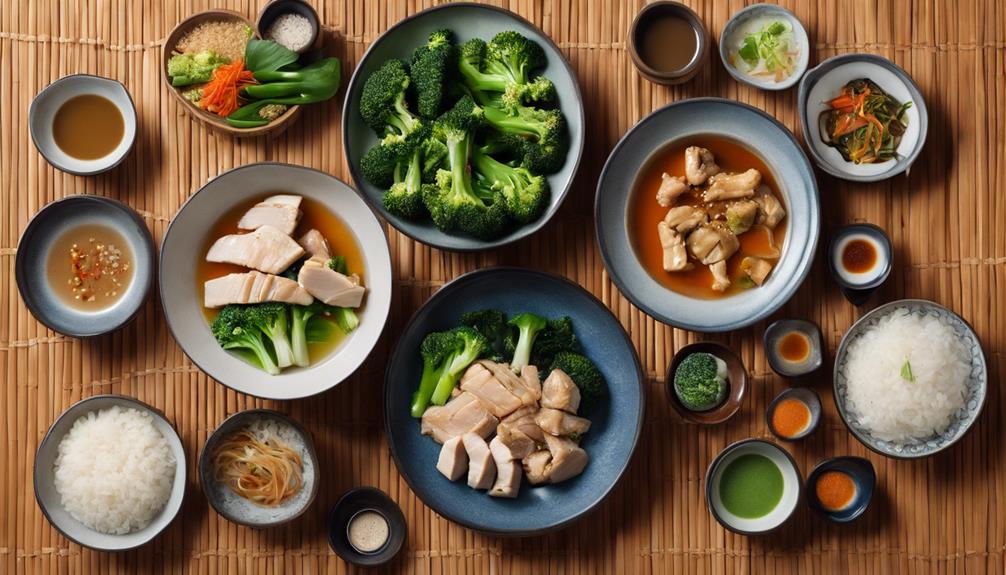Popular Healthy Chinese Cuisine Options

You’ve got plenty of Healthy Chinese Cuisine Options to choose from! Steamed dumplings make a great snack, packed with nutritious fillings. Try a vibrant vegetable stir-fry for a colorful side dish that’s quick to prepare. Lean proteins like chicken and fish are excellent choices, especially when paired with brown rice or quinoa. Enjoy a warm bowl of miso soup, rich in probiotics, or add pickled vegetables for extra flavor on your plate. Don’t forget herbal teas and fresh fruit for dessert! Discover even more delicious and nutritious options that fit your lifestyle by exploring further.
Steamed Dumplings
Steamed dumplings are a delightful and healthy choice in Chinese cuisine that you can easily enjoy. With their traditional fillings, like pork, shrimp, or vegetables, these dumplings deliver rich flavor profiles that cater to various tastes. You’ll find that the cooking techniques involved, primarily steaming, keep the dumplings light and nutritious, making them an excellent meal prep option.
When it comes to serving suggestions, you can pair steamed dumplings with a variety of dipping sauces, such as soy sauce, chili oil, or vinegar. These sauces not only enhance the flavor but also add a touch of cultural significance to your meal. You’ll appreciate the balance of flavors and textures, especially when you consider portion sizes; a few dumplings can serve as a delightful appetizer or a satisfying main course.
One of the key health benefits of steamed dumplings lies in their lower calorie count compared to fried varieties. By sourcing fresh, quality ingredients, you guarantee that your dumplings are packed with nutrients. Whether you’re making them at home or choosing them at a restaurant, understanding the ingredient sourcing can help you make healthier choices.
Incorporating steamed dumplings into your meals can elevate your dining experience, combining culinary tradition with modern health-conscious eating. So, the next time you’re looking for a tasty yet nutritious dish, don’t overlook these lovely little parcels!
Vegetable Stir-Fry
A vibrant vegetable stir-fry is a fantastic way to enjoy a healthy meal that bursts with flavor and color. You can easily whip up this dish using seasonal vegetables, making it not only nutritious but also a celebration of what’s fresh and available. Think bell peppers, broccoli, snap peas, and carrots—these veggies provide a delightful crunch and a spectrum of vitamins.
To make your stir-fry shine, focus on a few essential cooking techniques. Start by heating a wok or large skillet over high heat, allowing it to get nice and hot. This helps to sear the vegetables quickly, preserving their colors and nutrients. Use a splash of oil—like sesame or olive oil—to coat the pan. Once the oil shimmers, toss in your chopped seasonal vegetables. Stir-fry them for just a few minutes, guaranteeing they remain crisp and vibrant.
To enhance the flavor, consider adding garlic, ginger, or a splash of soy sauce at the end. These ingredients infuse your stir-fry with depth without overpowering the natural taste of the vegetables. Remember to keep stirring constantly to avoid burning and guarantee even cooking.
Serving your vegetable stir-fry over a bed of greens or as a side dish can elevate your meal. It’s an easy, quick option that fits perfectly into a busy lifestyle while keeping your meals healthy and satisfying. Enjoy the deliciousness of a vegetable stir-fry, and relish in the colorful array of seasonal veggies!
Brown Rice Alternatives
When it comes to healthy grains, you’ve got several delicious brown rice alternatives to choose from that can elevate your meals. Incorporating these options not only adds variety but also boosts nutritional value. One of the top quinoa substitutes is the versatile quinoa itself, rich in protein and fiber, making it a fantastic base for stir-fries or bowls. If you’re looking for barley options, consider using hulled barley, which has a chewy texture and nutty flavor, perfect for hearty dishes.
For those who love whole grain alternatives, farro choices offer a unique taste and a delightful chew. It’s great in salads or as a side dish, soaking up flavors beautifully. Additionally, millet dishes bring a mild sweetness and are naturally gluten-free, making them suitable for many diets. You can easily prepare millet as a fluffy side, or mix it into stir-fries for added texture.
If you’re keen on experimenting, brown rice blends that combine various grains, like wild rice or red rice, can create a colorful and flavorful side. These blends not only enhance your meals aesthetically but also provide different nutrients. So, whether you’re using quinoa, barley, farro, or millet, each alternative presents its unique benefits. Don’t hesitate to mix and match these grains in your healthy Chinese cuisine ventures to discover new and exciting flavors!
Lean Protein Choices
Choosing lean protein options not only enhances your meals but also supports a healthy lifestyle. When you think of protein in Chinese cuisine, don’t overlook the variety of choices available. Lean meats like chicken, turkey, and fish are excellent options that can be easily incorporated into stir-fries or steamed dishes. These proteins are low in fat and high in nutrients, making them a perfect fit for your healthy meal plan.
If you’re looking for plant-based options, consider tofu alternatives like tempeh or edamame. These not only provide a great source of protein but also pack in fiber and other essential nutrients. You can experiment with different flavors by marinating or grilling these alternatives, giving your meals a delicious twist.
Don’t forget about protein combinations! Pairing your lean proteins with whole grains, like quinoa or brown rice, can enhance the overall nutritional profile of your meal. Additionally, adding a variety of colorful vegetables not only makes your plate visually appealing but also boosts the nutrient density.
Miso Soup Benefits
Miso soup is more than just a comforting dish; it packs a nutritional punch that you might not expect. By enjoying it regularly, you can support your immune system and boost your digestive health. Let’s explore the benefits that make miso soup a staple in healthy cuisine.
Nutritional Value Overview
One bowl of miso soup offers a wealth of nutritional benefits that can enhance your overall well-being. With a low caloric content, typically around 40 calories per serving, it’s a guilt-free addition to your meals. This makes it an excellent choice if you’re watching your calorie intake while still wanting something satisfying.
Miso, the primary ingredient, is rich in probiotics, which can support gut health. You’ll also find it packed with essential vitamins and minerals that contribute to a balanced diet. Miso serves as a great vitamin source, particularly B vitamins like riboflavin and B6, which are important for energy metabolism and overall health.
Additionally, the seaweed often included in miso soup provides iodine, supporting thyroid function, and it’s also a source of antioxidants that can help combat oxidative stress.
Immune System Support
A warm bowl of miso soup can do wonders for your immune system. Packed with probiotics from fermented miso paste, this dish enhances gut health, which is vital for overall immunity. By incorporating seasonal vegetables, you boost the nutrient density of your meal, delivering essential vitamins and minerals that act as immune boosters.
You can further elevate the benefits by adding superfood spices like ginger and garlic. These antioxidant-rich ingredients not only add flavor but also support your body’s natural defenses through their anti-inflammatory properties. Additionally, traditional herbs such as shiitake mushrooms and green onions provide potent herbal remedies that promote wellness.
When you enjoy miso soup regularly, you’re embracing holistic approaches to health. With each slurp, you’re nourishing your body with a comforting dish that prioritizes your immune system. This wellness practice can be especially beneficial during cold and flu seasons, helping you stay resilient.
Digestive Health Benefits
Enjoying a warm bowl of miso soup not only boosts your immune system but also offers significant digestive health benefits. Miso soup is packed with probiotic foods, which are essential for maintaining a healthy gut. These probiotics help balance your gut flora, making it easier for your digestive system to function effectively.
The fermentation process that creates miso introduces beneficial bacteria, enhancing your overall digestive health. In addition, miso soup is rich in digestive enzymes that aid in breaking down food, allowing your body to absorb nutrients more efficiently. This can lead to improved digestion and reduced bloating after meals.
Hot and Sour Soup
Hot and Sour Soup is a delicious choice that packs a punch in both flavor and nutrition. You’ll find that its key ingredients offer various health benefits, while its preparation methods are surprisingly simple. Let’s explore what makes this soup a standout in healthy Chinese cuisine.
Nutritional Benefits Explained
While you savor a bowl of hot and sour soup, you’re not just indulging in a delicious dish; you’re also reaping numerous nutritional benefits. This soup boasts low caloric content, making it a great option for those practicing portion control. The balance of flavor profiles provides a satisfying experience without excessive calories.
You can enhance the nutrient density by opting for seasonal ingredients like fresh mushrooms or leafy greens, which align with current health trends. When meal planning, consider pairing hot and sour soup with a side of steamed vegetables or brown rice to create a well-rounded meal.
Experimenting with ingredient substitutions, such as using tofu instead of meat, allows you to cater to dietary preferences while maintaining rich flavors. Additionally, various cooking methods, like steaming or simmering, can preserve nutrients while keeping the soup hearty.
Key Ingredients Overview
A rich blend of flavors makes hot and sour soup a standout dish, with its key ingredients playing a crucial role in achieving that perfect balance. You’ll find traditional spices like white pepper and vinegar, which create that signature heat and tang. The use of fresh ingredients, such as mushrooms and bamboo shoots, enhances the soup’s flavor profiles while offering various health benefits.
When planning your meals, consider the cooking techniques involved, as they can influence the soup’s overall taste. For instance, sautéing the ingredients before adding broth can deepen the flavors. Keep in mind that regional variations exist, which may introduce different ingredients or spice levels.
It’s also essential to address health misconceptions surrounding hot and sour soup. Many assume it’s unhealthy due to its rich taste, but with mindful ingredient sourcing, you can create a nutritious version that accommodates dietary restrictions. Opting for low-sodium broth or incorporating more vegetables can make this dish a healthier choice. By understanding these key ingredients, you’ll appreciate hot and sour soup not just as a dish, but as a versatile option for various dietary needs.
Preparation Methods Simplified
Preparing hot and sour soup is easier than you might think, and with just a few simple steps, you can create a delicious, homemade version. Start by gathering your ingredients: tofu, mushrooms, bamboo shoots, and scallions. You’ll also need soy sauce, vinegar, and white pepper for that signature flavor.
Begin by sautéing your vegetables in a pot over medium heat. This helps to enhance their flavors and maintain proper cooking temperatures. Next, add the broth and bring it to a gentle simmer. While the soup simmers, incorporate your tofu and any other proteins you like.
To achieve that perfect balance of flavors, you can use fermentation techniques, like adding a splash of fermented black beans or a dash of soy sauce. These ingredients not only add depth but also contribute to the soup’s unique taste profile.
Once everything’s cooked through, thicken your soup with a cornstarch slurry, stirring continuously. Finally, adjust the seasoning with vinegar and white pepper to achieve your desired level of heat and tanginess. Serve hot, and enjoy your homemade hot and sour soup that’s both healthy and satisfying!
Szechuan Style Health Tips
Szechuan cuisine often surprises diners with its bold flavors and spicy kick, but you can enjoy it healthily with a few simple adjustments. To start, focus on the ingredients you choose. Opt for lean proteins like chicken, shrimp, or tofu instead of fatty cuts of meat. This helps you create balanced meals that are lower in calories but still packed with flavor.
When it comes to those spicy flavors Szechuan is famous for, don’t shy away from using fresh chilies, garlic, and ginger. These ingredients not only elevate the taste but also provide health benefits like boosting your metabolism and enhancing digestion. You can control the heat by adjusting the amount of chili paste or oil you use, allowing you to enjoy the signature spice without overwhelming your palate.
Incorporating plenty of vegetables is another important tip. Szechuan dishes often feature a variety of colorful veggies, so load your plate with bell peppers, broccoli, and bok choy. This practice not only adds essential nutrients but also helps maintain that desired crunch and texture, making your meals more satisfying.
Lastly, watch your serving sizes and be mindful of sauces. Many Szechuan dishes can be high in sodium and sugar due to their sauces. Consider using homemade sauces with reduced sodium soy sauce or vinegar, ensuring your meals remain flavorful without sacrificing your health. By making these simple changes, you can enjoy Szechuan cuisine while keeping it nutritious and delicious.
Buddha’s Delight
Buddha’s Delight is a fantastic dish packed with nutritional benefits that you’ll love. You can customize it with various ingredients, making it a versatile option for any meal. Let’s explore how this dish can boost your health while satisfying your taste buds.
Nutritional Benefits Explained
A colorful medley of vegetables and tofu, Buddha’s Delight offers a feast for both the eyes and the palate. This dish is packed with nutritional benefits that align perfectly with contemporary health trends. By utilizing traditional herbs and mindful cooking techniques, you’re not only enhancing flavor profiles but also boosting the dish’s health benefits.
When meal planning, Buddha’s Delight fits seamlessly into various dietary restrictions, whether you’re vegan, vegetarian, or simply looking to reduce meat intake. The combination of seasonal dishes means you can source fresh ingredients, ensuring ideal nutrient retention.
Portion control is another advantage; you can enjoy a satisfying meal without overindulging. The rich array of vegetables provides essential vitamins and minerals that promote overall wellness. Additionally, the cultural influences behind this dish highlight the importance of balance in nutrition, combining flavors and textures to create a harmonious meal.
Ingredient Variations Available
When preparing Buddha’s Delight, you can easily customize the ingredients to suit your taste and dietary preferences. Start by selecting your vegetable combinations; options like bok choy, mushrooms, and bell peppers not only add color but also nutrition. You can also play around with protein variations. If you’re vegetarian, tofu or tempeh works well, while those who eat meat might consider chicken or shrimp as ingredient substitutions.
For flavor enhancements, think about seasoning alternatives like ginger, garlic, or soy sauce. These can elevate your dish considerably. If you prefer a gluten-free option, tamari can serve as a fantastic sauce alternative.
Cooking techniques can also be adjusted; you might stir-fry, steam, or even bake your ingredients based on your preferences. When it comes to meal prep, consider grain options like brown rice or quinoa to make your Buddha’s Delight more filling.
Don’t hesitate to experiment with different flavors and textures, ensuring each dish reflects your unique culinary style. With these variations, you’ll create a delicious, healthy meal that aligns perfectly with your dietary preferences.
Steamed Fish Dishes
Steamed fish dishes are not only a staple in healthy Chinese cuisine but also a delightful way to enjoy fresh, flavorful ingredients. When you choose to steam fish, you preserve its natural moisture and enhance its taste without adding unnecessary fats. This method allows the delicate flavors of the fish to shine through, making each bite a true culinary experience.
To elevate your steamed fish, use flavorful marinades that complement the dish. Traditional ingredients like ginger, garlic, and scallions add depth, while soy sauce or rice wine brings a savory touch. Simply marinate the fish for about 30 minutes before cooking, allowing the flavors to meld beautifully.
When it comes to cooking techniques, steaming can be done in various ways. You can use a bamboo steamer, which imparts a subtle aroma to the fish, or a metal steamer for convenience. Whichever method you choose, make sure to set your steamer over boiling water and cover it tightly to trap the steam. Cooking times will vary depending on the thickness of the fish, so check for doneness by ensuring the flesh flakes easily with a fork.
Pair your steamed fish with a side of steamed vegetables or brown rice, and you’ve got a well-rounded meal that’s both nutritious and satisfying. By incorporating these flavorful marinades and efficient cooking techniques, you’ll enjoy a dish that’s not only healthy but also bursting with flavor. Immerse yourself and relish the goodness of steamed fish!
Low-Sodium Sauces
For those looking to enjoy flavorful Chinese dishes without the excess sodium, low-sodium sauces are a game changer. You don’t have to sacrifice taste for health; instead, you can explore a variety of low sodium alternatives that enhance your meals without compromising on flavor.
Start by swapping out traditional soy sauce for low-sodium versions. These alternatives retain that classic umami taste while greatly reducing your sodium intake. You can also experiment with homemade sauces, combining ingredients like vinegar, ginger, garlic, and sesame oil to create a rich, flavorful base that’s low in salt. Incorporating fresh herbs like cilantro or green onions can further provide a delightful flavor enhancement.
Don’t forget about alternatives like tamari or coconut aminos, which are naturally lower in sodium and can be used in stir-fries, marinades, or dipping sauces. By using these substitutes, you’ll find that you can still achieve depth and complexity in your dishes.
When preparing dishes, consider using broth or stock that’s labeled low-sodium. This simple swap can turn a bland dish into something savory and satisfying without the excess salt.
Pickled Vegetables
Adding pickled vegetables to your meals can elevate the flavor profile while providing a healthy crunch. The fermentation benefits of pickling not only enhance the taste but also serve as a great source of probiotics, supporting gut health. You can easily experiment with various pickling techniques, from quick pickles to traditional methods that allow for deeper flavor development.
These crunchy textures bring a delightful contrast to your dishes, making them perfect for healthful toppings on rice or noodles. With regional varieties like pickled mustard greens or spicy chili pickles, you can explore a world of flavors. Each region has its own preservation methods that contribute to the cultural significance of pickled vegetables in Chinese cuisine.
When you’re creating homemade recipes, consider how pickled vegetables can be used in meal pairings. They complement stir-fries beautifully or can be served alongside grilled meats, adding a burst of acidity that balances rich flavors. The nutrient retention during the pickling process guarantees that you’re not just adding flavor but also keeping the health benefits intact.
Moreover, you can get creative with your pickling, incorporating ingredients like garlic or ginger for flavor enhancements. The traditional uses of pickled vegetables in meals have stood the test of time, making them a staple in both everyday dishes and festive occasions. So, don’t hesitate to include these vibrant additions to your meals for a nutritious and flavorful boost!
Herbal Teas
The soothing comfort of herbal teas makes them a cherished aspect of healthy Chinese cuisine. These beverages not only offer delightful flavor profiles but also boast numerous health benefits. You’ll find a wide range of tea varieties, each with unique herbal properties. From chrysanthemum and goji berry to ginseng and pu-erh, these teas serve as excellent caffeine alternatives, allowing you to enjoy a warm drink without the jitters.
Traditional practices emphasize the importance of brewing techniques for maximizing flavor and health benefits. Steeping the herbs at the right temperature for the appropriate duration enhances their effectiveness as a digestive aid or detoxification benefit. For instance, peppermint tea can soothe an upset stomach, while ginger tea can help with digestion and provide relaxation effects.
Herbal teas hold significant cultural importance in Chinese society, often enjoyed as part of family gatherings or during seasonal celebrations. By using seasonal ingredients, you can create herbal blends that resonate with the changing environment, making your tea experience even more invigorating.
Incorporating herbal teas into your daily routine can lead to improved overall well-being. Whether you sip on a calming chamomile before bed or a revitalizing mint tea after meals, you’ll appreciate how these beverages support both your health and your enjoyment of food. So, embrace the world of herbal teas and discover how they can enhance your culinary journey in healthy Chinese cuisine.
Fresh Fruit Desserts
During warm summer evenings, fresh fruit desserts shine as a delightful way to finish a meal in healthy Chinese cuisine. You can explore a variety of options that not only satisfy your sweet tooth but also incorporate the goodness of seasonal fruits. Start with a vibrant fruit salad, bursting with flavors from juicy peaches, ripe mangoes, and invigorating melons. This simple yet delicious dish is a crowd-pleaser.
If you’re looking for something a bit more unique, try herbal desserts infused with traditional Chinese ingredients like goji berries or chrysanthemum. They provide a fragrant twist, making them a perfect companion to your fruit salad. For a revitalizing treat, tropical sorbets made from blended fruits like pineapple or coconut can be a delightful palate cleanser.
Coconut pudding offers a creamy alternative, pairing wonderfully with sweet rice for a comforting texture. You might also enjoy chia pudding, which is not only nutritious but can be layered with fresh fruits for added color and taste. For a more indulgent option, whip up yogurt parfaits layered with granola and fruit compote, creating a balanced dessert that feels decadent.
Don’t forget about berry tartlets; their crisp crusts and luscious fillings make them an elegant choice. These fresh fruit desserts prove that healthy eating doesn’t have to be boring. So, indulge in these delightful treats and savor the natural sweetness of fruits in every bite!
Frequently Asked Questions: Healthy Chinese Cuisine Options
What Are Some Common Allergens in Chinese Cuisine?
When exploring Chinese cuisine, be mindful of common allergens like soy sauce allergies and sesame seed sensitivities. These ingredients can trigger reactions, so always check labels or ask about them when dining out.
How Can I Modify Recipes for Gluten-Free Options?
To modify recipes for gluten-free options, you can use gluten-free sauces and substitute traditional flours with alternative flours like almond or rice flour. This way, you’ll enjoy delicious dishes without gluten.
Are There Any Traditional Chinese Herbs Beneficial for Digestion?
Yes, you can explore digestive herbs like ginger and peppermint. They’re known for their soothing properties. Using herbal remedies, you can enhance your digestion and overall well-being. Just incorporate them into your daily routine!
What Are the Health Benefits of Chinese Medicinal Teas?
Chinese medicinal teas offer numerous health benefits. You’ll find various tea varieties, like chrysanthemum and pu-erh, boasting unique health properties. Drinking these teas can enhance digestion, boost immunity, and promote relaxation, making them a delightful choice.
How Can I Incorporate More Plant-Based Dishes Into Chinese Meals?
To incorporate more plant-based dishes into your Chinese meals, try using plant-based substitutions like tofu and tempeh in vegetable stir fries. Experiment with various vegetables to create colorful, nutritious dishes that are both tasty and satisfying.
Conclusion
Incorporating these healthy Chinese cuisine options into your meals can make a big difference in your overall well-being. Steamed dumplings, vibrant vegetable stir-fries, and lean protein choices not only satisfy your taste buds but also nourish your body. Opt for brown rice alternatives and low-sodium sauces to keep your meals balanced. Don’t forget the benefits of miso soup, pickled veggies, and invigorating herbal teas. Enjoy fresh fruit desserts for a sweet ending, and you’ll feel great inside and out!








